5CI001 IS/IT Management Essay: Managing Projects and Provisions
VerifiedAdded on 2021/03/22
|8
|3092
|66
Essay
AI Summary
This essay, written for a School of Computing and Information Technology course (5CI001) on IS/IT Management, addresses key challenges faced by IS/IT managers. It delves into issues in managing IS/IT projects, such as communication gaps, inadequate planning, resistance to change, and technological advancements. The essay also explores issues related to managing the IS/IT provision within an organization, including cost-benefit analyses, changes to organizational culture, data security concerns, and user-related problems. Furthermore, it examines the role of benefits management in ensuring that IS/IT projects and provisions achieve their anticipated benefits. The essay concludes with a discussion of emerging trends in IS/IT management, emphasizing the importance of adapting to evolving organizational structures and resource allocation strategies. The essay provides a comprehensive overview of the multifaceted responsibilities of IS/IT managers and the strategies for successful IT implementation.
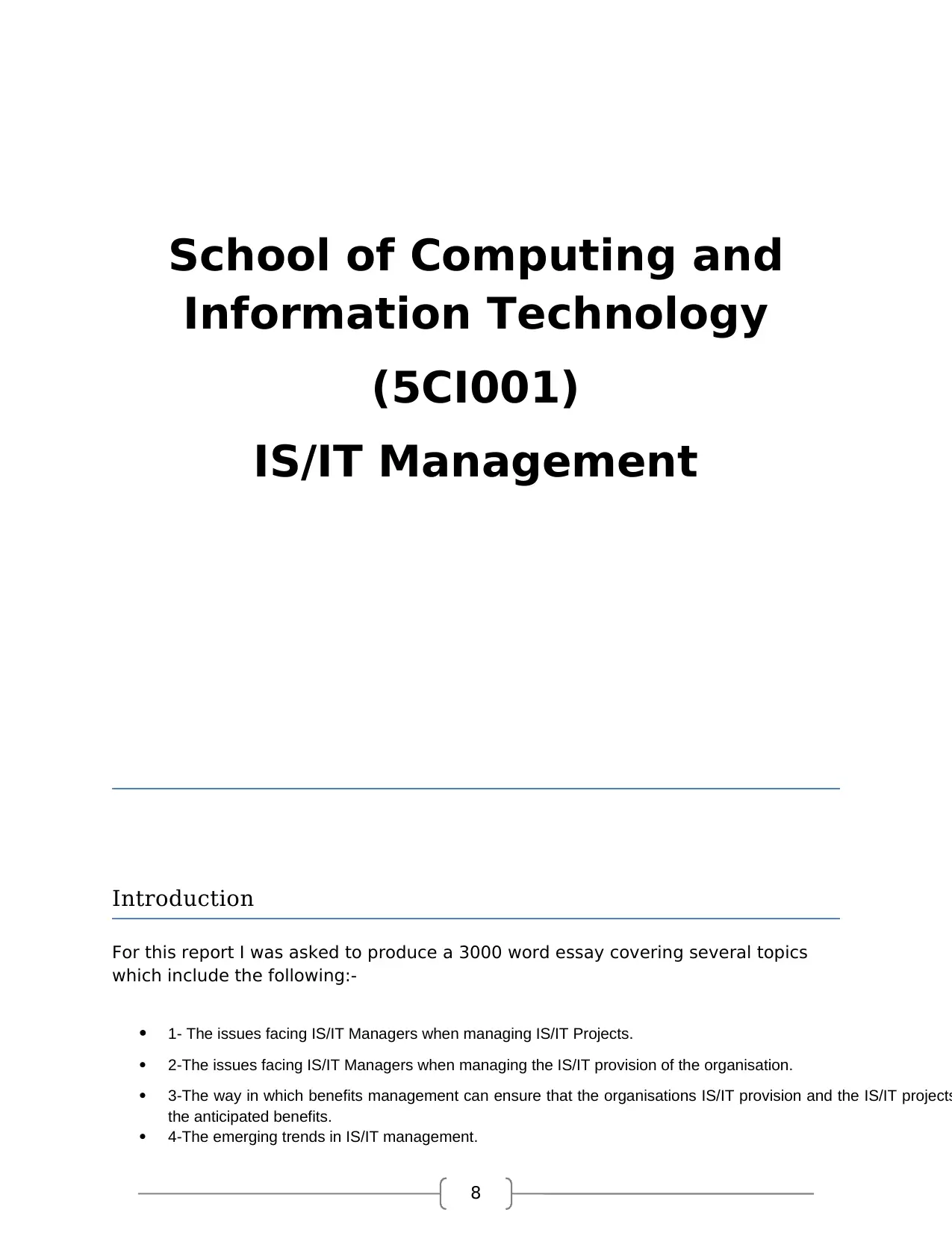
8
School of Computing and
Information Technology
(5CI001)
IS/IT Management
Introduction
For this report I was asked to produce a 3000 word essay covering several topics
which include the following:-
1- The issues facing IS/IT Managers when managing IS/IT Projects.
2-The issues facing IS/IT Managers when managing the IS/IT provision of the organisation.
3-The way in which benefits management can ensure that the organisations IS/IT provision and the IS/IT projects
the anticipated benefits.
4-The emerging trends in IS/IT management.
School of Computing and
Information Technology
(5CI001)
IS/IT Management
Introduction
For this report I was asked to produce a 3000 word essay covering several topics
which include the following:-
1- The issues facing IS/IT Managers when managing IS/IT Projects.
2-The issues facing IS/IT Managers when managing the IS/IT provision of the organisation.
3-The way in which benefits management can ensure that the organisations IS/IT provision and the IS/IT projects
the anticipated benefits.
4-The emerging trends in IS/IT management.
Paraphrase This Document
Need a fresh take? Get an instant paraphrase of this document with our AI Paraphraser
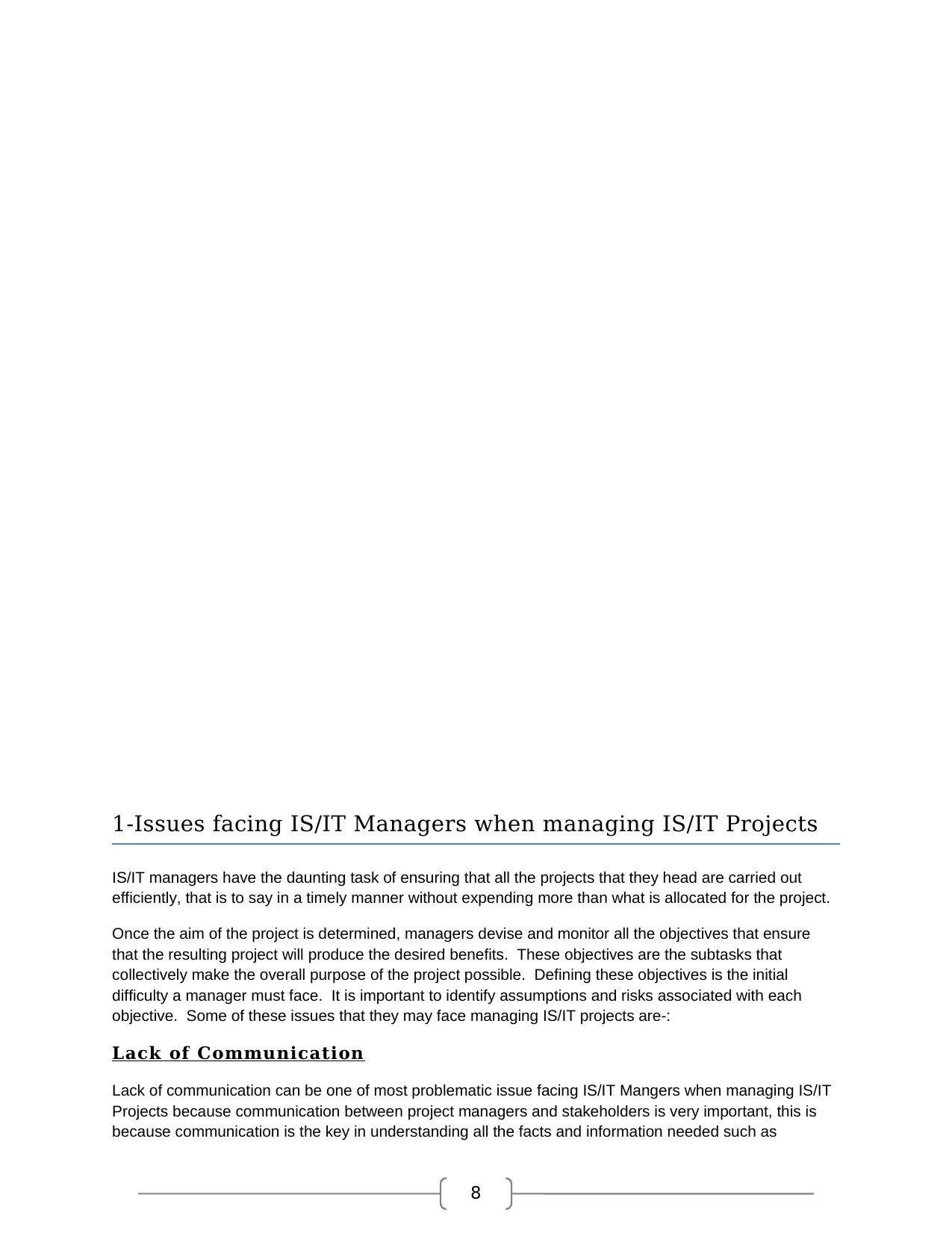
8
1-Issues facing IS/IT Managers when managing IS/IT Projects
IS/IT managers have the daunting task of ensuring that all the projects that they head are carried out
efficiently, that is to say in a timely manner without expending more than what is allocated for the project.
Once the aim of the project is determined, managers devise and monitor all the objectives that ensure
that the resulting project will produce the desired benefits. These objectives are the subtasks that
collectively make the overall purpose of the project possible. Defining these objectives is the initial
difficulty a manager must face. It is important to identify assumptions and risks associated with each
objective. Some of these issues that they may face managing IS/IT projects are-:
Lack of Communication
Lack of communication can be one of most problematic issue facing IS/IT Mangers when managing IS/IT
Projects because communication between project managers and stakeholders is very important, this is
because communication is the key in understanding all the facts and information needed such as
1-Issues facing IS/IT Managers when managing IS/IT Projects
IS/IT managers have the daunting task of ensuring that all the projects that they head are carried out
efficiently, that is to say in a timely manner without expending more than what is allocated for the project.
Once the aim of the project is determined, managers devise and monitor all the objectives that ensure
that the resulting project will produce the desired benefits. These objectives are the subtasks that
collectively make the overall purpose of the project possible. Defining these objectives is the initial
difficulty a manager must face. It is important to identify assumptions and risks associated with each
objective. Some of these issues that they may face managing IS/IT projects are-:
Lack of Communication
Lack of communication can be one of most problematic issue facing IS/IT Mangers when managing IS/IT
Projects because communication between project managers and stakeholders is very important, this is
because communication is the key in understanding all the facts and information needed such as

8
timeframes to complete the project successfully. Communication between these two will also help avoid
insufficient budgeting and assumptions when planning and budgeting.
Inadequate Budget/ Planning
A manager has to be aware of the progress of the project throughout its duration. This begins with having
a plan devised as to what is going to be done and when. They use this plan to formulate a budget for the
project and determine the feasibility of the project. This means that the manager has to be in constant
communication with all persons involved in the fulfilment of the project objectives. From these
communications the managers can gather how the team is working by comparing the progress to that
scheduled in the plan. In the event that the project has fallen behind, the manager has the task of
determining whether to extend the project deadlines and/or budgets. As an alternative to these actions,
the managers often decide whether there are more effective ways to put the derailed project back on
schedule.
Resistant to Change
A project often disrupts the accustomed process of the organisation and as a result stirs resistance to
change. This resistance becomes evident as persistent reduction delays and interruptions in workflows,
resentments and staff refusal to work. The managers have to be aware of these mind-sets and moderate
them early on. This is best addressed by incorporating the employees’ perspectives into the projects so
that their participation directs the change. In order for the management to deal with the staff’s attitude
they need to highlight new principles for staff specialists and encourage them to think in different ways.
Technology Change
Technology is constantly changing and which each evolution, items are created or modified to enhance a
user’s ability to do a particular process. It is because of these improvements that businesses need to be
aware of relevance advances such as competition. A project manager is tasked with ensuring that their
business is economical about the technology it acquires. As technology is acquired and implemented
within the business’ processes, the business itself changes and the project manager has to ensure that
workflow is kept up efficiently.
2-The issues facing IS/IT Managers when managing the IS/IT
provision of the organisation.
The management position ties in all aspects of the project. A manager has to understand the workings of
each division of the project to successfully monitor them. Some of these issues that they may face when
managing IS/IT provisions of the organisation are-:
Costs vs. Benefi ts
Even when there are major benefits to gaining new technology, a manager also has to consider the risks
involved when implementing a new system. A new system could, in one instance, increase productivity
by 60% but have a high initial cost, running expenditure, maintenance and a short time before it becomes
outdated. The manager has to be aware of all potential pros and cons of this technology.
There are a number of concerns that arise when a business implements new technology. The first
concern is the cost vs. benefit of providing new IS/IT. Every business takes into account what they will
timeframes to complete the project successfully. Communication between these two will also help avoid
insufficient budgeting and assumptions when planning and budgeting.
Inadequate Budget/ Planning
A manager has to be aware of the progress of the project throughout its duration. This begins with having
a plan devised as to what is going to be done and when. They use this plan to formulate a budget for the
project and determine the feasibility of the project. This means that the manager has to be in constant
communication with all persons involved in the fulfilment of the project objectives. From these
communications the managers can gather how the team is working by comparing the progress to that
scheduled in the plan. In the event that the project has fallen behind, the manager has the task of
determining whether to extend the project deadlines and/or budgets. As an alternative to these actions,
the managers often decide whether there are more effective ways to put the derailed project back on
schedule.
Resistant to Change
A project often disrupts the accustomed process of the organisation and as a result stirs resistance to
change. This resistance becomes evident as persistent reduction delays and interruptions in workflows,
resentments and staff refusal to work. The managers have to be aware of these mind-sets and moderate
them early on. This is best addressed by incorporating the employees’ perspectives into the projects so
that their participation directs the change. In order for the management to deal with the staff’s attitude
they need to highlight new principles for staff specialists and encourage them to think in different ways.
Technology Change
Technology is constantly changing and which each evolution, items are created or modified to enhance a
user’s ability to do a particular process. It is because of these improvements that businesses need to be
aware of relevance advances such as competition. A project manager is tasked with ensuring that their
business is economical about the technology it acquires. As technology is acquired and implemented
within the business’ processes, the business itself changes and the project manager has to ensure that
workflow is kept up efficiently.
2-The issues facing IS/IT Managers when managing the IS/IT
provision of the organisation.
The management position ties in all aspects of the project. A manager has to understand the workings of
each division of the project to successfully monitor them. Some of these issues that they may face when
managing IS/IT provisions of the organisation are-:
Costs vs. Benefi ts
Even when there are major benefits to gaining new technology, a manager also has to consider the risks
involved when implementing a new system. A new system could, in one instance, increase productivity
by 60% but have a high initial cost, running expenditure, maintenance and a short time before it becomes
outdated. The manager has to be aware of all potential pros and cons of this technology.
There are a number of concerns that arise when a business implements new technology. The first
concern is the cost vs. benefit of providing new IS/IT. Every business takes into account what they will
⊘ This is a preview!⊘
Do you want full access?
Subscribe today to unlock all pages.

Trusted by 1+ million students worldwide
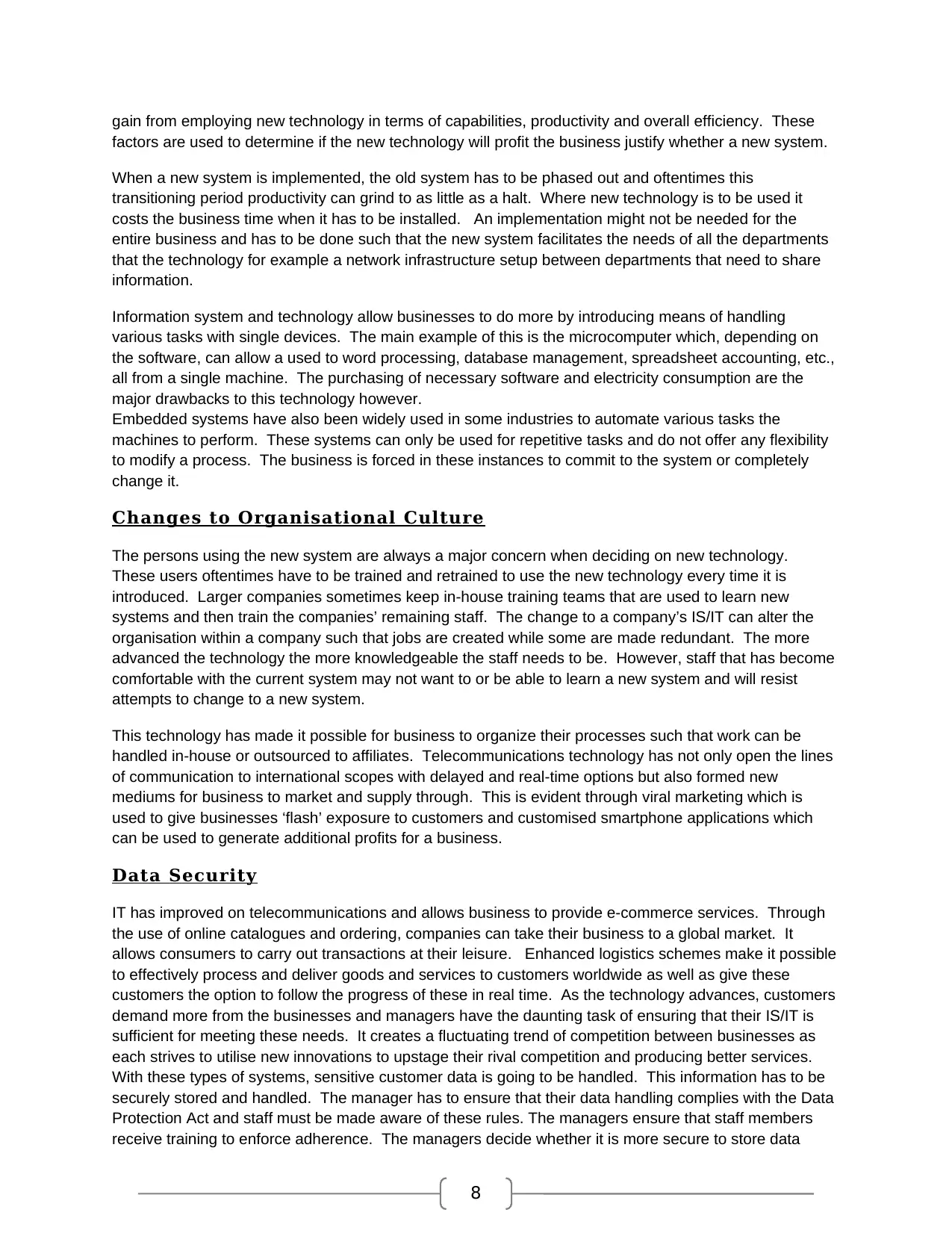
8
gain from employing new technology in terms of capabilities, productivity and overall efficiency. These
factors are used to determine if the new technology will profit the business justify whether a new system.
When a new system is implemented, the old system has to be phased out and oftentimes this
transitioning period productivity can grind to as little as a halt. Where new technology is to be used it
costs the business time when it has to be installed. An implementation might not be needed for the
entire business and has to be done such that the new system facilitates the needs of all the departments
that the technology for example a network infrastructure setup between departments that need to share
information.
Information system and technology allow businesses to do more by introducing means of handling
various tasks with single devices. The main example of this is the microcomputer which, depending on
the software, can allow a used to word processing, database management, spreadsheet accounting, etc.,
all from a single machine. The purchasing of necessary software and electricity consumption are the
major drawbacks to this technology however.
Embedded systems have also been widely used in some industries to automate various tasks the
machines to perform. These systems can only be used for repetitive tasks and do not offer any flexibility
to modify a process. The business is forced in these instances to commit to the system or completely
change it.
Changes to Organisational Culture
The persons using the new system are always a major concern when deciding on new technology.
These users oftentimes have to be trained and retrained to use the new technology every time it is
introduced. Larger companies sometimes keep in-house training teams that are used to learn new
systems and then train the companies’ remaining staff. The change to a company’s IS/IT can alter the
organisation within a company such that jobs are created while some are made redundant. The more
advanced the technology the more knowledgeable the staff needs to be. However, staff that has become
comfortable with the current system may not want to or be able to learn a new system and will resist
attempts to change to a new system.
This technology has made it possible for business to organize their processes such that work can be
handled in-house or outsourced to affiliates. Telecommunications technology has not only open the lines
of communication to international scopes with delayed and real-time options but also formed new
mediums for business to market and supply through. This is evident through viral marketing which is
used to give businesses ‘flash’ exposure to customers and customised smartphone applications which
can be used to generate additional profits for a business.
Data Security
IT has improved on telecommunications and allows business to provide e-commerce services. Through
the use of online catalogues and ordering, companies can take their business to a global market. It
allows consumers to carry out transactions at their leisure. Enhanced logistics schemes make it possible
to effectively process and deliver goods and services to customers worldwide as well as give these
customers the option to follow the progress of these in real time. As the technology advances, customers
demand more from the businesses and managers have the daunting task of ensuring that their IS/IT is
sufficient for meeting these needs. It creates a fluctuating trend of competition between businesses as
each strives to utilise new innovations to upstage their rival competition and producing better services.
With these types of systems, sensitive customer data is going to be handled. This information has to be
securely stored and handled. The manager has to ensure that their data handling complies with the Data
Protection Act and staff must be made aware of these rules. The managers ensure that staff members
receive training to enforce adherence. The managers decide whether it is more secure to store data
gain from employing new technology in terms of capabilities, productivity and overall efficiency. These
factors are used to determine if the new technology will profit the business justify whether a new system.
When a new system is implemented, the old system has to be phased out and oftentimes this
transitioning period productivity can grind to as little as a halt. Where new technology is to be used it
costs the business time when it has to be installed. An implementation might not be needed for the
entire business and has to be done such that the new system facilitates the needs of all the departments
that the technology for example a network infrastructure setup between departments that need to share
information.
Information system and technology allow businesses to do more by introducing means of handling
various tasks with single devices. The main example of this is the microcomputer which, depending on
the software, can allow a used to word processing, database management, spreadsheet accounting, etc.,
all from a single machine. The purchasing of necessary software and electricity consumption are the
major drawbacks to this technology however.
Embedded systems have also been widely used in some industries to automate various tasks the
machines to perform. These systems can only be used for repetitive tasks and do not offer any flexibility
to modify a process. The business is forced in these instances to commit to the system or completely
change it.
Changes to Organisational Culture
The persons using the new system are always a major concern when deciding on new technology.
These users oftentimes have to be trained and retrained to use the new technology every time it is
introduced. Larger companies sometimes keep in-house training teams that are used to learn new
systems and then train the companies’ remaining staff. The change to a company’s IS/IT can alter the
organisation within a company such that jobs are created while some are made redundant. The more
advanced the technology the more knowledgeable the staff needs to be. However, staff that has become
comfortable with the current system may not want to or be able to learn a new system and will resist
attempts to change to a new system.
This technology has made it possible for business to organize their processes such that work can be
handled in-house or outsourced to affiliates. Telecommunications technology has not only open the lines
of communication to international scopes with delayed and real-time options but also formed new
mediums for business to market and supply through. This is evident through viral marketing which is
used to give businesses ‘flash’ exposure to customers and customised smartphone applications which
can be used to generate additional profits for a business.
Data Security
IT has improved on telecommunications and allows business to provide e-commerce services. Through
the use of online catalogues and ordering, companies can take their business to a global market. It
allows consumers to carry out transactions at their leisure. Enhanced logistics schemes make it possible
to effectively process and deliver goods and services to customers worldwide as well as give these
customers the option to follow the progress of these in real time. As the technology advances, customers
demand more from the businesses and managers have the daunting task of ensuring that their IS/IT is
sufficient for meeting these needs. It creates a fluctuating trend of competition between businesses as
each strives to utilise new innovations to upstage their rival competition and producing better services.
With these types of systems, sensitive customer data is going to be handled. This information has to be
securely stored and handled. The manager has to ensure that their data handling complies with the Data
Protection Act and staff must be made aware of these rules. The managers ensure that staff members
receive training to enforce adherence. The managers decide whether it is more secure to store data
Paraphrase This Document
Need a fresh take? Get an instant paraphrase of this document with our AI Paraphraser
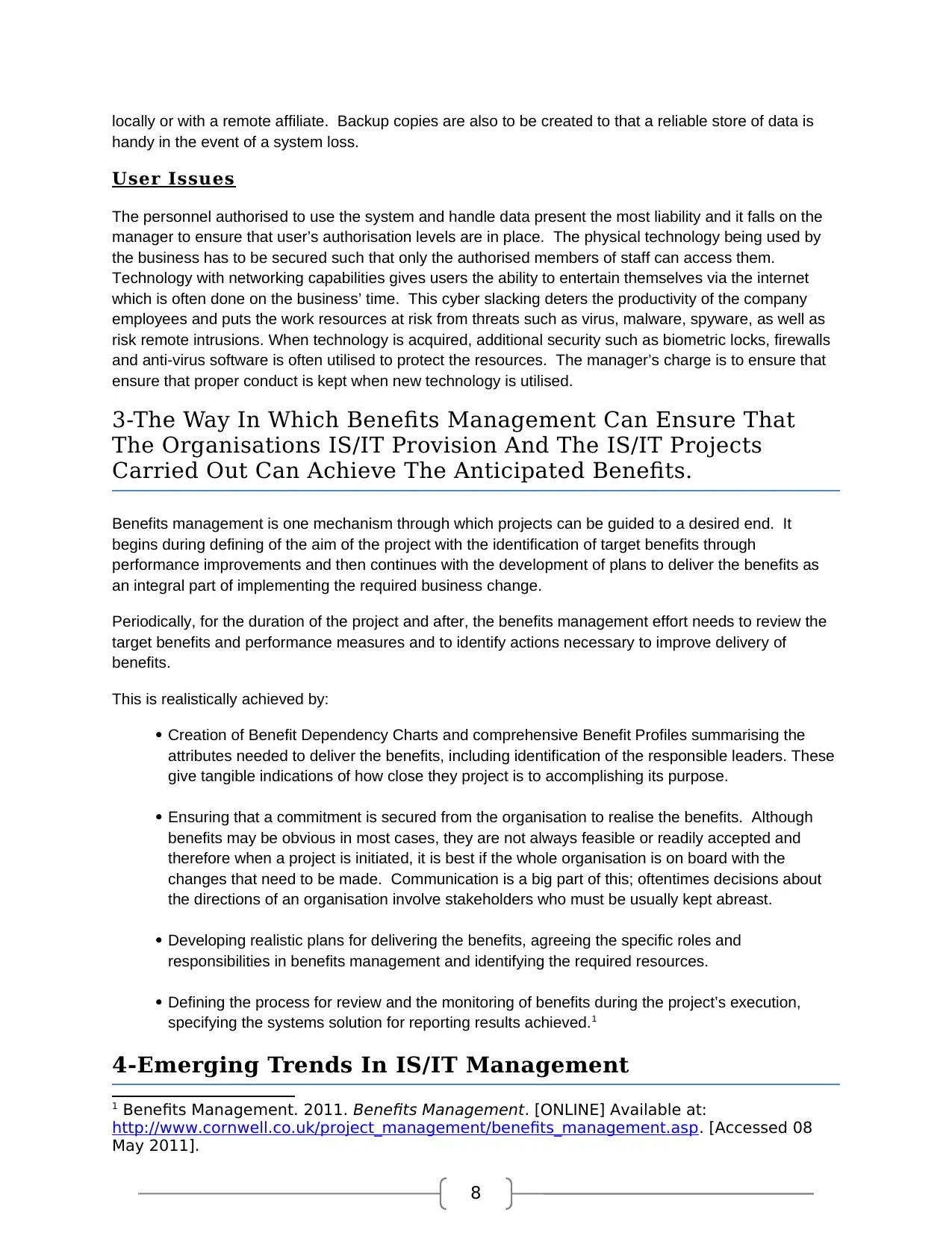
8
locally or with a remote affiliate. Backup copies are also to be created to that a reliable store of data is
handy in the event of a system loss.
User Issues
The personnel authorised to use the system and handle data present the most liability and it falls on the
manager to ensure that user’s authorisation levels are in place. The physical technology being used by
the business has to be secured such that only the authorised members of staff can access them.
Technology with networking capabilities gives users the ability to entertain themselves via the internet
which is often done on the business’ time. This cyber slacking deters the productivity of the company
employees and puts the work resources at risk from threats such as virus, malware, spyware, as well as
risk remote intrusions. When technology is acquired, additional security such as biometric locks, firewalls
and anti-virus software is often utilised to protect the resources. The manager’s charge is to ensure that
ensure that proper conduct is kept when new technology is utilised.
3-The Way In Which Benefits Management Can Ensure That
The Organisations IS/IT Provision And The IS/IT Projects
Carried Out Can Achieve The Anticipated Benefits.
Benefits management is one mechanism through which projects can be guided to a desired end. It
begins during defining of the aim of the project with the identification of target benefits through
performance improvements and then continues with the development of plans to deliver the benefits as
an integral part of implementing the required business change.
Periodically, for the duration of the project and after, the benefits management effort needs to review the
target benefits and performance measures and to identify actions necessary to improve delivery of
benefits.
This is realistically achieved by:
Creation of Benefit Dependency Charts and comprehensive Benefit Profiles summarising the
attributes needed to deliver the benefits, including identification of the responsible leaders. These
give tangible indications of how close they project is to accomplishing its purpose.
Ensuring that a commitment is secured from the organisation to realise the benefits. Although
benefits may be obvious in most cases, they are not always feasible or readily accepted and
therefore when a project is initiated, it is best if the whole organisation is on board with the
changes that need to be made. Communication is a big part of this; oftentimes decisions about
the directions of an organisation involve stakeholders who must be usually kept abreast.
Developing realistic plans for delivering the benefits, agreeing the specific roles and
responsibilities in benefits management and identifying the required resources.
Defining the process for review and the monitoring of benefits during the project’s execution,
specifying the systems solution for reporting results achieved.1
4-Emerging Trends In IS/IT Management
1 Benefits Management. 2011. Benefits Management. [ONLINE] Available at:
http://www.cornwell.co.uk/project_management/benefits_management.asp. [Accessed 08
May 2011].
locally or with a remote affiliate. Backup copies are also to be created to that a reliable store of data is
handy in the event of a system loss.
User Issues
The personnel authorised to use the system and handle data present the most liability and it falls on the
manager to ensure that user’s authorisation levels are in place. The physical technology being used by
the business has to be secured such that only the authorised members of staff can access them.
Technology with networking capabilities gives users the ability to entertain themselves via the internet
which is often done on the business’ time. This cyber slacking deters the productivity of the company
employees and puts the work resources at risk from threats such as virus, malware, spyware, as well as
risk remote intrusions. When technology is acquired, additional security such as biometric locks, firewalls
and anti-virus software is often utilised to protect the resources. The manager’s charge is to ensure that
ensure that proper conduct is kept when new technology is utilised.
3-The Way In Which Benefits Management Can Ensure That
The Organisations IS/IT Provision And The IS/IT Projects
Carried Out Can Achieve The Anticipated Benefits.
Benefits management is one mechanism through which projects can be guided to a desired end. It
begins during defining of the aim of the project with the identification of target benefits through
performance improvements and then continues with the development of plans to deliver the benefits as
an integral part of implementing the required business change.
Periodically, for the duration of the project and after, the benefits management effort needs to review the
target benefits and performance measures and to identify actions necessary to improve delivery of
benefits.
This is realistically achieved by:
Creation of Benefit Dependency Charts and comprehensive Benefit Profiles summarising the
attributes needed to deliver the benefits, including identification of the responsible leaders. These
give tangible indications of how close they project is to accomplishing its purpose.
Ensuring that a commitment is secured from the organisation to realise the benefits. Although
benefits may be obvious in most cases, they are not always feasible or readily accepted and
therefore when a project is initiated, it is best if the whole organisation is on board with the
changes that need to be made. Communication is a big part of this; oftentimes decisions about
the directions of an organisation involve stakeholders who must be usually kept abreast.
Developing realistic plans for delivering the benefits, agreeing the specific roles and
responsibilities in benefits management and identifying the required resources.
Defining the process for review and the monitoring of benefits during the project’s execution,
specifying the systems solution for reporting results achieved.1
4-Emerging Trends In IS/IT Management
1 Benefits Management. 2011. Benefits Management. [ONLINE] Available at:
http://www.cornwell.co.uk/project_management/benefits_management.asp. [Accessed 08
May 2011].
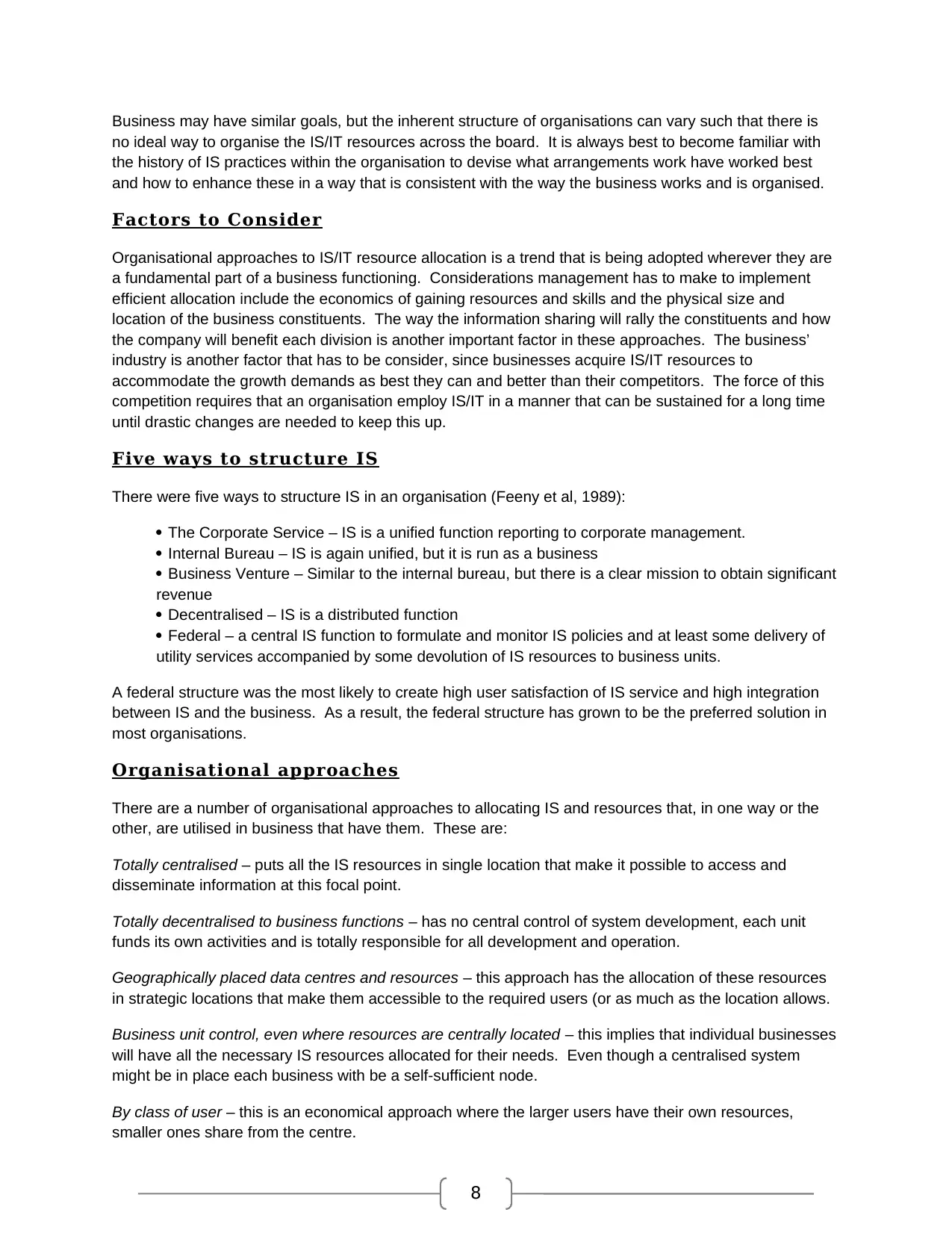
8
Business may have similar goals, but the inherent structure of organisations can vary such that there is
no ideal way to organise the IS/IT resources across the board. It is always best to become familiar with
the history of IS practices within the organisation to devise what arrangements work have worked best
and how to enhance these in a way that is consistent with the way the business works and is organised.
Factors to Consider
Organisational approaches to IS/IT resource allocation is a trend that is being adopted wherever they are
a fundamental part of a business functioning. Considerations management has to make to implement
efficient allocation include the economics of gaining resources and skills and the physical size and
location of the business constituents. The way the information sharing will rally the constituents and how
the company will benefit each division is another important factor in these approaches. The business’
industry is another factor that has to be consider, since businesses acquire IS/IT resources to
accommodate the growth demands as best they can and better than their competitors. The force of this
competition requires that an organisation employ IS/IT in a manner that can be sustained for a long time
until drastic changes are needed to keep this up.
Five ways to structure IS
There were five ways to structure IS in an organisation (Feeny et al, 1989):
The Corporate Service – IS is a unified function reporting to corporate management.
Internal Bureau – IS is again unified, but it is run as a business
Business Venture – Similar to the internal bureau, but there is a clear mission to obtain significant
revenue
Decentralised – IS is a distributed function
Federal – a central IS function to formulate and monitor IS policies and at least some delivery of
utility services accompanied by some devolution of IS resources to business units.
A federal structure was the most likely to create high user satisfaction of IS service and high integration
between IS and the business. As a result, the federal structure has grown to be the preferred solution in
most organisations.
Organisational approaches
There are a number of organisational approaches to allocating IS and resources that, in one way or the
other, are utilised in business that have them. These are:
Totally centralised – puts all the IS resources in single location that make it possible to access and
disseminate information at this focal point.
Totally decentralised to business functions – has no central control of system development, each unit
funds its own activities and is totally responsible for all development and operation.
Geographically placed data centres and resources – this approach has the allocation of these resources
in strategic locations that make them accessible to the required users (or as much as the location allows.
Business unit control, even where resources are centrally located – this implies that individual businesses
will have all the necessary IS resources allocated for their needs. Even though a centralised system
might be in place each business with be a self-sufficient node.
By class of user – this is an economical approach where the larger users have their own resources,
smaller ones share from the centre.
Business may have similar goals, but the inherent structure of organisations can vary such that there is
no ideal way to organise the IS/IT resources across the board. It is always best to become familiar with
the history of IS practices within the organisation to devise what arrangements work have worked best
and how to enhance these in a way that is consistent with the way the business works and is organised.
Factors to Consider
Organisational approaches to IS/IT resource allocation is a trend that is being adopted wherever they are
a fundamental part of a business functioning. Considerations management has to make to implement
efficient allocation include the economics of gaining resources and skills and the physical size and
location of the business constituents. The way the information sharing will rally the constituents and how
the company will benefit each division is another important factor in these approaches. The business’
industry is another factor that has to be consider, since businesses acquire IS/IT resources to
accommodate the growth demands as best they can and better than their competitors. The force of this
competition requires that an organisation employ IS/IT in a manner that can be sustained for a long time
until drastic changes are needed to keep this up.
Five ways to structure IS
There were five ways to structure IS in an organisation (Feeny et al, 1989):
The Corporate Service – IS is a unified function reporting to corporate management.
Internal Bureau – IS is again unified, but it is run as a business
Business Venture – Similar to the internal bureau, but there is a clear mission to obtain significant
revenue
Decentralised – IS is a distributed function
Federal – a central IS function to formulate and monitor IS policies and at least some delivery of
utility services accompanied by some devolution of IS resources to business units.
A federal structure was the most likely to create high user satisfaction of IS service and high integration
between IS and the business. As a result, the federal structure has grown to be the preferred solution in
most organisations.
Organisational approaches
There are a number of organisational approaches to allocating IS and resources that, in one way or the
other, are utilised in business that have them. These are:
Totally centralised – puts all the IS resources in single location that make it possible to access and
disseminate information at this focal point.
Totally decentralised to business functions – has no central control of system development, each unit
funds its own activities and is totally responsible for all development and operation.
Geographically placed data centres and resources – this approach has the allocation of these resources
in strategic locations that make them accessible to the required users (or as much as the location allows.
Business unit control, even where resources are centrally located – this implies that individual businesses
will have all the necessary IS resources allocated for their needs. Even though a centralised system
might be in place each business with be a self-sufficient node.
By class of user – this is an economical approach where the larger users have their own resources,
smaller ones share from the centre.
⊘ This is a preview!⊘
Do you want full access?
Subscribe today to unlock all pages.

Trusted by 1+ million students worldwide

8
By activity - operations centralised, development decentralised etc.
While there is no ideal approach, there are a number of operations that are carried out in business that
should be in a centralised manner. Earl suggests that some tasks are best left to be handled this way:
Formulation of group IT strategy and architecture
Derivation of clear standards and policies
Guiding hardware, software and consulting acquisition
Monitoring group standards and policies
Providing group communications requirements
Meeting corporate IS needs
Coordinating human resource development.
With a centralised approach, a number of provisions and activities that might also be produced:
Consultancy services
IT assistance for small units and technical support for large units
Taking inventories of planned and installed hardware and software
Providing system audit and review services
Facilitating technology transfer
Facilities managing shared services
Initiating and providing education courses and doing IT experiments.
Steering Committees
Managing IT arrangements at the corporate level is an obvious necessity, but it is difficult to successfully
accomplish this. One mechanism for making the organisational arrangements for IT is to establish one or
more steering committees. These committees plan and control IT resources at the corporate level.
Using a group in this manner makes it possible to incorporate the needs of the specific constituents by
including respective members from them. Information systems span all these constituent business units,
departments and functions of these organisations, for that reason a coordinating structure is needed to
decide how to allocate limited IT resources and to plan system developments. Another reason for
creating steering committees for IT arrangement is because IT is cross-functional and impacts on the
whole organisation, the key information management policy issues cannot be delegated to the IT function.
Conclusion
In conclusion I have researched and studied the course resources in order to help me conduct this report
to the best of my ability, discussing that although project managing is a difficult tasks it is very important in
the success of helping managers in obtaining a successful project and business. I also discussed ways in
which management can ensure that they can be successful.
By activity - operations centralised, development decentralised etc.
While there is no ideal approach, there are a number of operations that are carried out in business that
should be in a centralised manner. Earl suggests that some tasks are best left to be handled this way:
Formulation of group IT strategy and architecture
Derivation of clear standards and policies
Guiding hardware, software and consulting acquisition
Monitoring group standards and policies
Providing group communications requirements
Meeting corporate IS needs
Coordinating human resource development.
With a centralised approach, a number of provisions and activities that might also be produced:
Consultancy services
IT assistance for small units and technical support for large units
Taking inventories of planned and installed hardware and software
Providing system audit and review services
Facilitating technology transfer
Facilities managing shared services
Initiating and providing education courses and doing IT experiments.
Steering Committees
Managing IT arrangements at the corporate level is an obvious necessity, but it is difficult to successfully
accomplish this. One mechanism for making the organisational arrangements for IT is to establish one or
more steering committees. These committees plan and control IT resources at the corporate level.
Using a group in this manner makes it possible to incorporate the needs of the specific constituents by
including respective members from them. Information systems span all these constituent business units,
departments and functions of these organisations, for that reason a coordinating structure is needed to
decide how to allocate limited IT resources and to plan system developments. Another reason for
creating steering committees for IT arrangement is because IT is cross-functional and impacts on the
whole organisation, the key information management policy issues cannot be delegated to the IT function.
Conclusion
In conclusion I have researched and studied the course resources in order to help me conduct this report
to the best of my ability, discussing that although project managing is a difficult tasks it is very important in
the success of helping managers in obtaining a successful project and business. I also discussed ways in
which management can ensure that they can be successful.
Paraphrase This Document
Need a fresh take? Get an instant paraphrase of this document with our AI Paraphraser
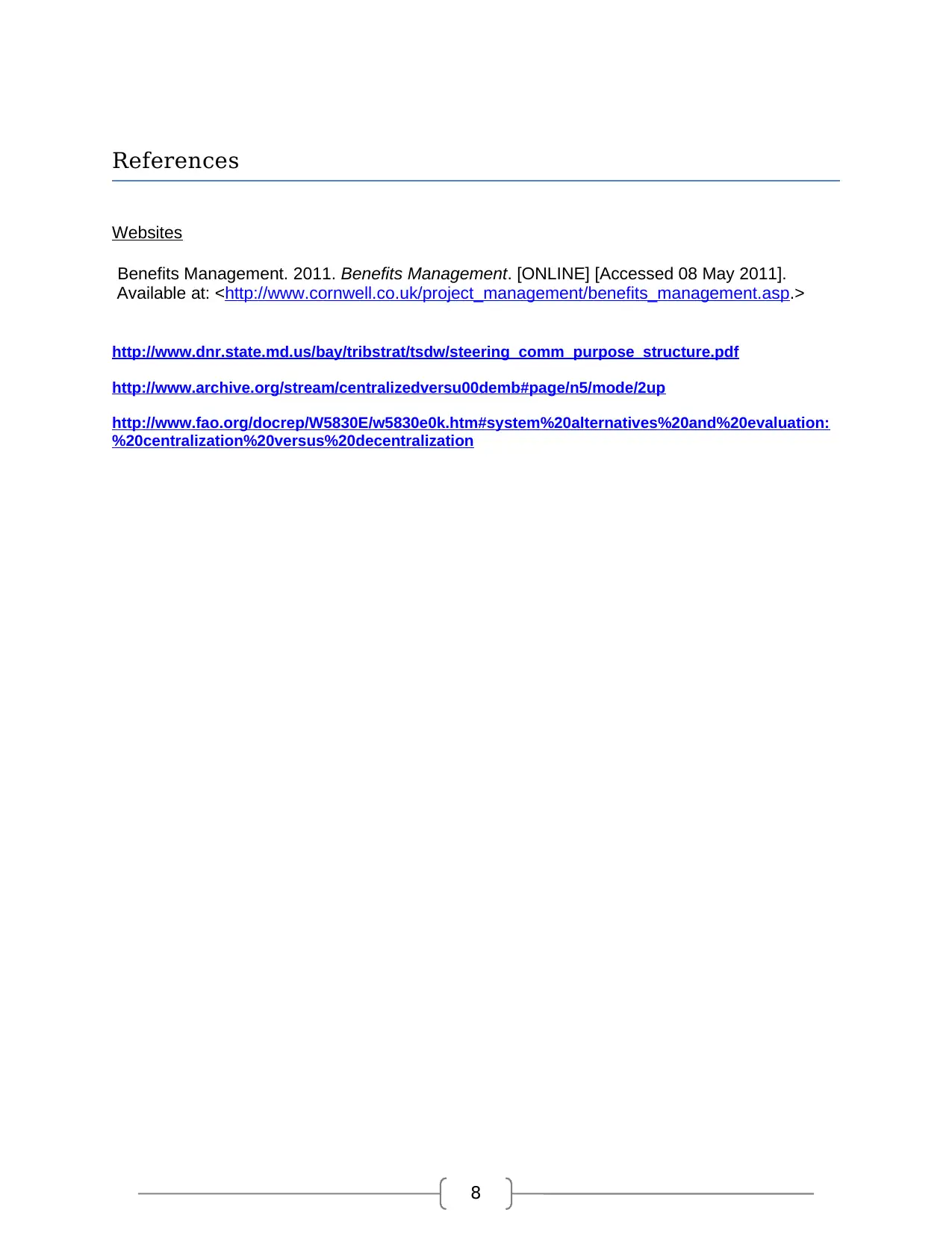
8
References
Websites
Benefits Management. 2011. Benefits Management. [ONLINE] [Accessed 08 May 2011].
Available at: <http://www.cornwell.co.uk/project_management/benefits_management.asp.>
http://www.dnr.state.md.us/bay/tribstrat/tsdw/steering_comm_purpose_structure.pdf
http://www.archive.org/stream/centralizedversu00demb#page/n5/mode/2up
http://www.fao.org/docrep/W5830E/w5830e0k.htm#system%20alternatives%20and%20evaluation:
%20centralization%20versus%20decentralization
References
Websites
Benefits Management. 2011. Benefits Management. [ONLINE] [Accessed 08 May 2011].
Available at: <http://www.cornwell.co.uk/project_management/benefits_management.asp.>
http://www.dnr.state.md.us/bay/tribstrat/tsdw/steering_comm_purpose_structure.pdf
http://www.archive.org/stream/centralizedversu00demb#page/n5/mode/2up
http://www.fao.org/docrep/W5830E/w5830e0k.htm#system%20alternatives%20and%20evaluation:
%20centralization%20versus%20decentralization
1 out of 8
Related Documents
Your All-in-One AI-Powered Toolkit for Academic Success.
+13062052269
info@desklib.com
Available 24*7 on WhatsApp / Email
![[object Object]](/_next/static/media/star-bottom.7253800d.svg)
Unlock your academic potential
Copyright © 2020–2025 A2Z Services. All Rights Reserved. Developed and managed by ZUCOL.





